Revisiting the cycletrack element of my Silver Spring mobility and innovation district concept
As part of my broader series of articles about how to introduce complementary improvements across the transit network simultaneously with the development and opening of the Purple Line light rail program in Montgomery and Prince George's Counties in Maryland, I wrote a subset of articles applying that idea and vision more broadly to one of the districts that will enjoy access to this transit service, the conurbation of Silver Spring, outlining a wide-ranging vision for an integrated sustainable mobility and innovation district.
The article series
-- Setting the stage for the Purple Line light rail line to be an overwhelming success: Part 1 | simultaneously introduce improvements to other elements of the transit network
-- Part 2 | the program (macro changes)
-- Part 3 | influences
-- Part 4 | Making over New Carrollton as a transit-centric urban center and Prince George's County's "New Downtown"
-- PL #5: Creating a Silver Spring "Sustainable Mobility District"
- Part 1: Setting the stage
- Part 2: Program items 1- 9
- Part 3: Program items 10-18
- Part 4: Conclusion
- Map for the Silver Spring Sustainable Mobility District
- (Big Hairy) Projects Action Plan(s) as an element of Comprehensive/Master Plans
- A proposal for creating the Silver Spring/Montgomery County Arena and Recreation Center
-- PL #6 | Creating a transportation development authority in Montgomery and Prince George's County to effectuate placemaking, retail development, and housing programs in association with the Purple Line
-- PL #7 | Using the Purple Line to rebrand Montgomery and Prince George's Counties as Design Forward
The first recommendations for the improvement program was to create what I called "Sustainable Mobility Corridors" on Fenton Street and East-West Highway (and to some extent on Colesville Road).
These corridors would be highly visible and central and would provide high quality bicycling infrastructure and facilities complemented by improvements to the pedestrian network and to the surface transit system (bus shelters).
I made the point that by comparison the County's project to create a high quality cycletrack on Silver Spring's ring road -- Second Avenue + Spring Street + Cedar Street -- would not be visible or highly used, because it doesn't serve the central parts of the district. Instead the cycletrack bypasses the core of Silver Spring.
The design of the "Connective Corridor" between Syracuse University and the city's Downtown is along the lines of what I am thinking.

While the execution of the cycletrack on the ring road of Second Avenue-Spring Street-Cedar Street by the Montgomery County Department of Transportation is very good, I believe the final product proves my point.
It's great for people seeking to avoid the center of Silver Spring and it isn't so great for people seeking to bike to AND WITHIN the center.
Furthermore, it doesn't create a "sustainable mobility corridor." Instead it adds a cycletrack to a road that is dominated by motor vehicles.
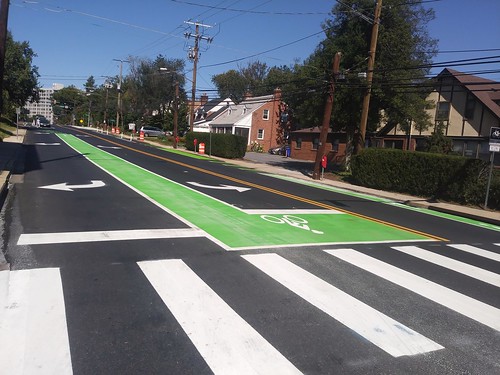
Green painted bike box at the intersection with Wayne Avenue, Cedar Street cycletrack, Silver Spring.
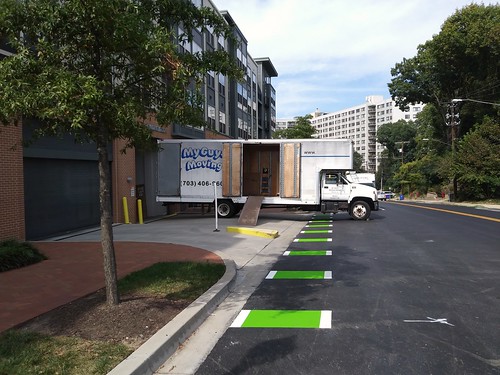
Separately, note that the new Wharf development on the Washington Channel in DC's Southwest Quadrant has installed German-Dutch-Denmark style separated cycletrack + sidewalk within the "sidewalk" right of way on the northern perimeter of the development, on I Street SW.
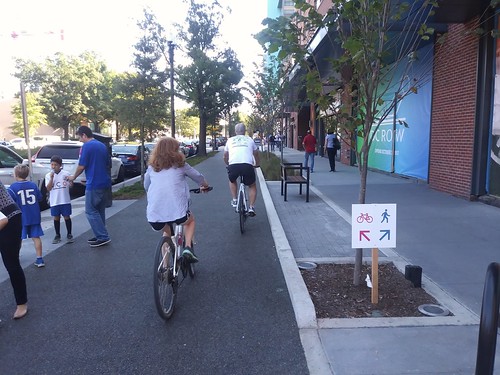

Bicycle lane,marked in red pavers, "on the sidewalk" in Hamburg, Germany.
However, The Wharf expects high volume pedestrian traffic and the sidewalk width is inadequate compared to the planned-for volumes. Therefore, it will be hard to keep The Wharf's I Street SW cycletrack free of pedestrians.
Hopefully, cyclists will understand that in an infrastructure environment that is mixed use, for safety reasons faster moving cyclists need to be focused on riding slower and deferring to pedestrians, unlike Justin Haller of Spokane, Washington ("Woman sues 'hot pizza' bicyclist who crashed into her along Centennial Trail," Spokane Spokesman-Review). From the article:
The 67-year-old woman injured when a bicyclist yelled “hot pizza” and then crashed into her along the Centennial Trail is suing the rider. ...This is a problem on "trails" or more properly termed "shared use paths," when a subset of cyclists believe that they should be able to ride as fast as possible, that slower "traffic" should defer to them. This is a form of what I call "designing conflict in," when the purpose of planning and engineering is to design unsafe conflict out.
“Like some sort of asinine idiot, he plowed right into her,” said Dunn. “Instead of acting like a reasonable adult, the guy had road rage, acting like some sort of potentate of the pathway.” ...
In an interview, Haller denied any wrongdoing. He called the collision an “accident” and blamed the unsafe mix of walkers and cyclists on the trail.
“You shouldn’t have a place where you have five times the speed discrepancy,” he said, noting that cyclists are allowed to reach up to 15 mph on the trail, where most people walk 3 mph. “If I were going to hop onto a highway going 12 mph, don’t you think I should look out for bigger and faster moving vehicles?"
Justin Haller is no different than a motor vehicle operator who believes s/he is entitled to the road over cyclists, pedestrians and other traffic.
Labels: bicycle and pedestrian planning, transportation planning, urban design/placemaking
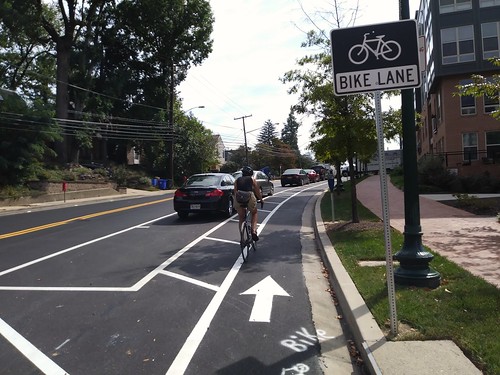
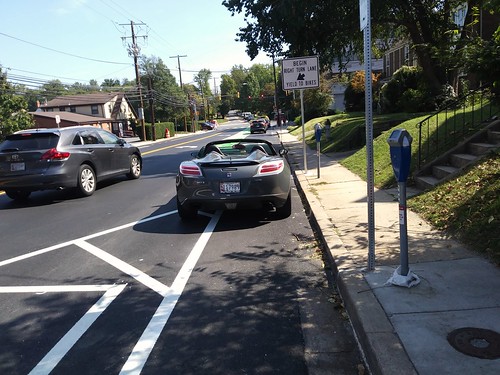
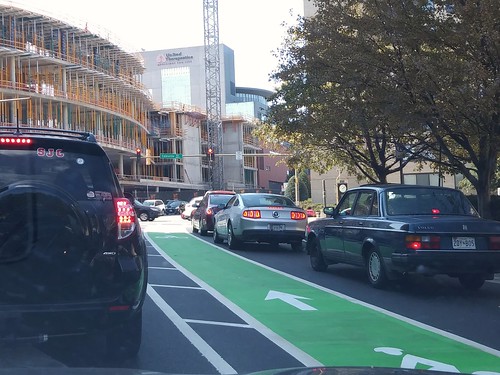
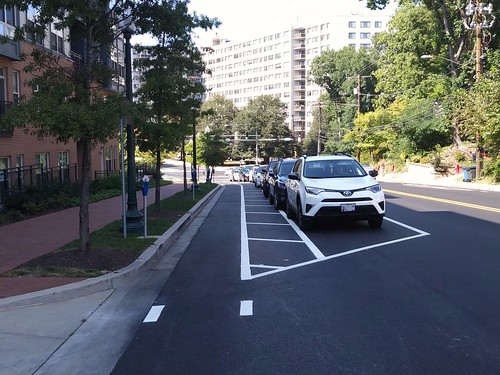



1 Comments:
Vehicular cycling is a ridiculous concept. Most responsible parents would never allow their children to use any “ bike lane “ in a major road. Sidewalk based bikeways are civilized and practical. Catering to macho male athletic cyclists and neglecting everyone else is foolish and elitist
Post a Comment
<< Home